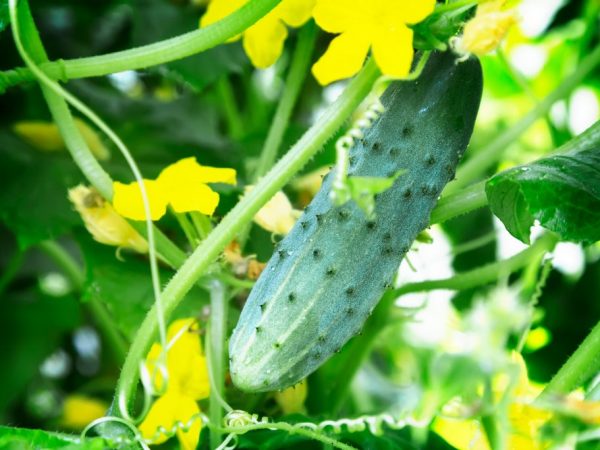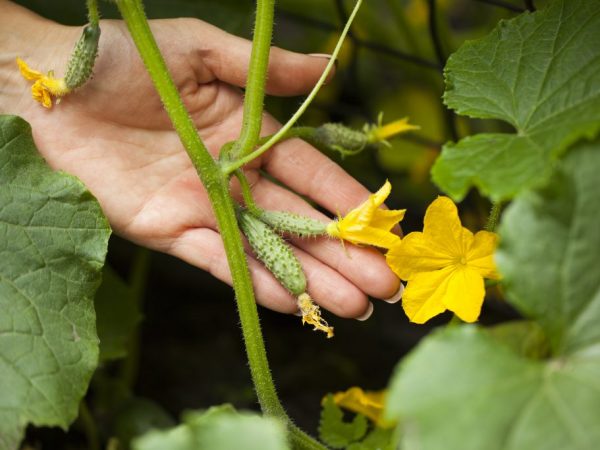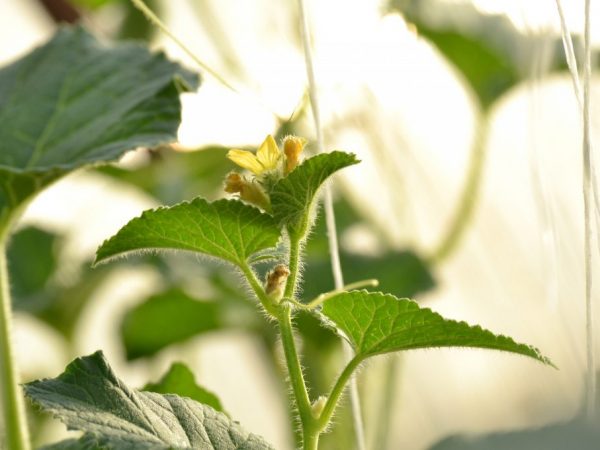Features of growing cucumbers in a polycarbonate greenhouse
Constant changes in weather conditions are forcing people to look for alternatives to growing cucumbers outdoors. The best option for your own plot is a small polycarbonate greenhouse. Growing cucumbers in a polycarbonate greenhouse allows you to get a good harvest in a short time in unfavorable climatic conditions, for example, as in the Moscow region.

Growing cucumbers in a polycarbonate greenhouse
Before growing cucumbers in a polycarbonate greenhouse, you need to decide on a place for the construction and choose the right variety of cucumbers. The following varieties are best suited for growing cucumbers in a polycarbonate greenhouse: Nezhinsky, Talisman, Alliance, Farmer, Masha F1. Self-pollinated varieties are also suitable for such conditions. They do not require pollination by bees, so they can be grown even in winter. F1 hybrids are excellent for growing in greenhouse conditions.
Premises preparation
You can assemble the frame with your own hands from a metal profile or wooden boards. A shelter is made from polycarbonate sheets on top. It is very important to equip an elementary ventilation system in advance in order to avoid the spread of fungal infection.
In addition, it is necessary to install a drip irrigation system and conduct lighting in order to create optimal conditions for the growth and development of cucumbers. The walls of the greenhouse must be treated with a disinfectant solution. Potassium permanganate is perfect for this.
It is necessary to pre-install the trellises to which the bushes will be tied. This must be done so that the foliage does not lie on the ground and the branches of the bushes do not get confused with each other.
Soil preparation
The yield will depend on how correctly the seedlings are grown. First, you need to prepare the container and soil. For seedlings, it is better to choose oblong pots. Drainage holes must be made in the bottom of the containers.
You can make the soil mixture yourself or buy a universal soil in the store. When self-mixing, the soil is pre-calcined in the oven to avoid contamination of plants with infections and fungi in the early stages of development.
The soil mixture is made from peat, humus and sawdust in proportions of 2: 2: 1. To ensure the normal growth and development of cucumbers in the first stage, as fertilizer, you need to add a spoonful of ash and superphosphates. Before laying the soil, the container for growing must also be disinfected and washed. Then you need to fill up the soil and spill it with water. This must be done a day before planting the seeds.
The soil must be dug up 6-10 cm deep. Then fertilize with manure, peat and sawdust. To warm up the soil, before laying fertilizers, they practice warming with hay or straw mixed with manure.
Horse manure is considered one of the best. It allows you to warm up the soil by 70-80 ℃ and kill all bacteria. It is necessary to introduce such a heater at least 21 days before sowing the seeds, otherwise they will simply burn out.Bird droppings are an alternative insulation. It warms up the soil by 50-60 ℃ and also allows you to get rid of bacteria, it is applied 14 days before planting.
Growing seedlings
The seeds must be disinfected. To do this, they are placed in a slightly pink solution of potassium permanganate for 20 minutes. After that, the seeds are laid out on any natural fabric and watered with water. In this state, they are left for a day or more until they hatch. Landing is usually carried out in early spring, around the end of April.
Seeds must be sown in small depressions, no more than 1.5 cm, sprinkling with earth on top. Landing scheme 10x10 or 8x8. Cover the cucumber plantings on top with foil and put in a warm, bright place. When the first shoots appear, the film must be removed. It is very important to water or sprinkle daily to keep the soil moist enough, otherwise the seedlings will not grow well.

The plant needs regular watering
Cucumbers grow quite quickly. After 2 weeks, you may need to pick different pots or glasses. The sprouts must be removed along with a piece of land and planted in separate containers, with pre-prepared soil.
Disembarkation in a greenhouse
At home, seedlings develop very quickly. Transplantation to the greenhouse is carried out in 2-3 weeks, when 4-5 true leaves appear. Before planting the sprouts, they should be hardened. For this, the plant is rearranged to a cooler place. The temperature is reduced gradually, moving them back to a warm room at night.
A week before planting, you need to dig up the soil again in a polycarbonate greenhouse. The beds are formed 80 cm wide and 35 cm high in 60 cm increments. Next, you need to apply superphosphate fertilizers. You can spill the soil with a mullein diluted with water and cover with a film so that it warms up well. Seedlings should not be transplanted into cold soil.
On the day of planting in a polycarbonate greenhouse, you need to make holes corresponding in depth to the height of the glass in which the seedlings grow. The pits are formed in 2 rows with a width of 50 cm. Warm water should be poured into each pit. Plants are removed from the glasses along with an earthen lump and placed in prepared holes. It is recommended to mulch the soil around the stem with sawdust to retain moisture and warmth.
Care
Watering
Proper care of cucumbers in a polycarbonate greenhouse is the key to getting a good harvest. Watering is the main activity in the care of cucumbers. In the greenhouse, humidity must be maintained within 75%. For 1 m2 of soil, you will need 5 liters of water. On hot days, watering is carried out once every 2 days, on cool days, once every 3-4 days.
Watering is best done from 11 to 15 hours. When ovaries appear, the intensity of watering should be increased. It is not recommended to pour water directly under the root; it is best to form irrigation furrows next to the holes or organize drip irrigation. Cucumbers in a polycarbonate greenhouse will bear fruit all year round, if all the conditions for this are properly organized in the room.
Temperature

It is necessary to protect plants from temperature surges
Another factor affecting growth is normal temperature.
- There should be no sudden jumps.
- In the greenhouse, the temperature must be kept within 28 ℃, and the soil must not cool down by less than 13 ℃, otherwise the plants will not be able to consume water.
- Growing cucumbers in greenhouses, as well as in the open field, involves regular loosening of the soil.
- Cultivation should be carried out after watering, this will improve aeration.
It is important to mount the trellises along which the plants will climb up. To do this, at a height of 1.5-2 m, you need to pull horizontally a wire, from which twine down, reaching down to the top of the bushes. The garter is carried out when 6-8 sheets appear. The first side shoots must be pinched so that the plants grow only upward and not to the sides.
The top is stepson when the bush grows to a trellis, otherwise it will curl further. Passynching is carried out over 2-3 leaves, which grows over the top fruit.
Fertilization
To grow a good crop in a greenhouse, you shouldn't forget about top dressing. From a small area of the plant, useful substances are very quickly drawn out, therefore they very often suffer from vitamin deficiencies, and do not bear fruit well. It is especially important to apply fertilizers during the growing season, flowering.
Nitrogen and potassium fertilizers are applied before flowering. A great option is wood ash, urea, bird droppings. Poultry droppings and urea are not applied in their pure form, otherwise the roots of the plants may burn out. After applying top dressing, it is recommended to water it.
Pests and diseases
It would seem that greenhouses and greenhouses should reliably protect plants from diseases and attacks of parasites. But it happens that the plants begin to turn yellow and wither. Improper agricultural technology is one of the first reasons why cucumbers can hurt. Darkening of foliage most often signals poor ventilation of the room or excessive watering. It is very simple to remedy the situation, you just need to adjust the optimal temperature regime, ventilate the room more often and organize proper watering.
Whitefly eats vegetables outdoors and thrives in greenhouse conditions. Can cause significant damage to any plants. It multiplies rapidly. Whitefly larvae can survive in soil and on weed roots. To combat insects, glue traps are used; as a preventive measure, it is necessary to disinfect the soil, agricultural equipment and destroy weeds in time.
Powdery mildew very often appears in conditions of high humidity. White spots with a fluffy structure appear on the leaves. As a prophylaxis and treatment, spraying with a mullein or Fitoverm is used. The melon aphid quickly drinks the juice from the cucumbers, as a result, the plants dry out. As a treatment, a solution of red pepper or tobacco dust is used.
Final part
Polycarbonate greenhouses are great for growing cucumbers in winter or early spring. You can build a shelter for plants with your own hands. Knowing the secrets of proper cultivation and care of plants, you can grow a rich harvest and even engage in commercial activities. This is a good start for your business.
To grow healthy cucumbers, you must follow the rules of crop rotation, apply fertilizers on time and ensure an optimal indoor climate. It is important to choose the right seeds. It is better to give preference to self-pollinated remontant varieties. Growing them is quite simple, plus they bear fruit for a whole year.

